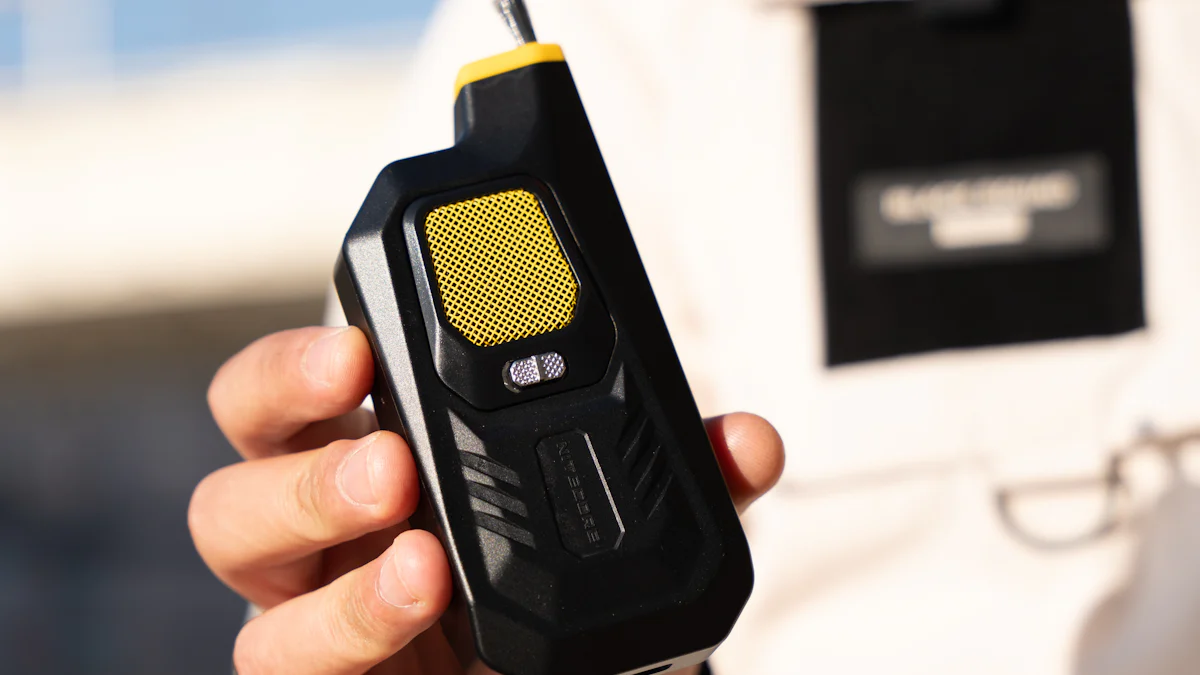
When it comes to Led Work Light, the options can be overwhelming. Understanding the significance of selecting the right type is crucial for optimal performance. Rechargeable LED tripod work lights and battery-powered LED tripod work lights offer distinct advantages, catering to different needs and preferences in various settings.
Portability and Convenience

When considering Led Work Light options, the aspect of portability and convenience plays a significant role in decision-making. The weight and mobility of both Rechargeable LED Tripod Work Lights and Battery-Powered LED Tripod Work Lights are crucial factors that impact their usability in various work environments.
Weight and Mobility
In the realm of LED tripod work lights, the weight and mobility are distinguishing features that set apart Rechargeable LED Tripod Work Lights from their Battery-Powered counterparts. The Rechargeable LED Tripod Work Lights, known for their cordless operation, offer a lightweight solution that enhances mobility on job sites. In contrast, the Battery-Powered LED Tripod Work Lights, powered by rechargeable batteries, provide a balance between portability and convenience with the added advantage of continuous illumination without being tethered to a power source.
Rechargeable LED Tripod Work Lights
- The Rechargeable LED Tripod Work Lights stand out for their ease of transportation due to their lightweight design. This feature allows users to move freely around work areas without being hindered by cumbersome equipment.
- With a focus on convenience, these work lights eliminate the need for constant battery replacements, providing a hassle-free lighting solution for various tasks.
- The portability of Rechargeable LED Tripod Work Lights makes them ideal for outdoor projects or locations where access to power outlets may be limited.
Battery-Powered LED Tripod Work Lights
- On the other hand, the Battery-Powered LED Tripod Work Lights offer enhanced mobility with their rechargeable battery packs. While slightly heavier than their rechargeable counterparts, these lights provide extended illumination without the constraints of power cords.
- The battery-powered feature ensures continuous operation without interruptions, making them suitable for tasks that require prolonged lighting solutions.
- Despite being heavier than rechargeable options, these work lights excel in scenarios where uninterrupted illumination is essential.
Ease of Use
The ease of use is another critical aspect when evaluating different types of LED tripod work lights. Factors such as setup, operation, charging methods, and battery replacement contribute to the overall user experience and efficiency in completing tasks.
Setup and Operation
- When it comes to setup and operation, both types of work lights offer user-friendly features that simplify usage for professionals across industries.
- The intuitive design of Rechargeable LED Tripod Work Lights ensures quick assembly and deployment on job sites without intricate installation processes.
- Similarly, the straightforward setup of Battery-Powered LED Tripod Work Lights allows users to start using the light immediately after unboxing.
Charging and Battery Replacement
- In terms of charging methods, Rechargeable LED Tripod Work Lights can be easily recharged through various power sources such as USB ports or AC adapters.
- Conversely, while Battery-Powered LED Tripod Work Lights do not require frequent recharging due to continuous battery operation, they may necessitate periodic battery replacements to maintain optimal performance.
led tripod work light
The choice between Rechargeable LED Tripod Work Lights and Battery-Powered LED Tripod Work Lights ultimately boils down to individual preferences regarding portability, convenience, ease of use, setup procedures, charging requirements, and maintenance considerations. Understanding these key differences can help users make informed decisions based on their specific needs.
Cost and Environmental Impact
In the realm of LED tripod work lights, evaluating the cost implications and environmental impact is paramount for informed decision-making. Understanding the initial investment, long-term costs, and environmental considerations associated with Rechargeable LED Tripod Work Lights and Battery-Powered LED Tripod Work Lights can guide users in selecting the most suitable lighting solution for their needs.
Initial Investment
Rechargeable LED Tripod Work Lights
- The initial investment in Rechargeable LED Tripod Work Lights may vary based on the brand and features offered.
- Users can expect a higher upfront cost compared to traditional lighting options due to the advanced technology and energy-efficient design.
- However, the durability and longevity of Rechargeable LED Tripod Work Lights justify the initial investment over time.
- The advent of LED technology has revolutionized the lighting industry, providing users with sustainable and cost-effective solutions.
Battery-Powered LED Tripod Work Lights
- Conversely, Battery-Powered LED Tripod Work Lights may require a lower initial investment due to the simpler design and battery-powered operation.
- While these lights offer a budget-friendly alternative, users should consider long-term costs associated with battery replacements.
- The global market trend towards energy-efficient lighting solutions underscores the importance of considering both short-term savings and long-term benefits when investing in Battery-Powered LED Tripod Work Lights.
Long-Term Costs
Maintenance and Battery Replacement
- When assessing long-term costs, maintenance plays a crucial role in determining the overall value of LED tripod work lights.
- Rechargeable LED Tripod Work Lights generally require minimal maintenance beyond occasional cleaning and battery management.
- In contrast, Battery-Powered LED Tripod Work Lights may incur additional expenses related to battery replacements over time.
- Prioritizing maintenance practices can extend the lifespan of both types of work lights, ensuring optimal performance throughout their usage.
Energy Consumption
- Energy consumption is a key consideration for users looking to minimize operational costs and reduce environmental impact.
- The energy efficiency of Rechargeable LED Tripod Work Lights contributes to lower electricity bills and reduced carbon footprint.
- On the other hand, Battery-Powered LED Tripod Work Lights may consume more power during extended use, leading to higher energy expenses over time.
- As industries shift towards sustainability initiatives, choosing energy-efficient lighting solutions like LED tripod work lights aligns with global trends towards eco-conscious practices.
Environmental Considerations
Sustainability
- Sustainable practices are at the forefront of modern industries, driving demand for environmentally friendly products like LED tripod work lights.
- The durability and energy efficiency of Rechargeable LED Tripod Work Lights promote sustainable usage while reducing waste from disposable batteries.
- By investing in sustainable lighting solutions, users contribute to conservation efforts and support a greener future for generations to come.
Waste Reduction
- Waste reduction is a critical aspect of environmental stewardship when using lighting equipment in various applications.
- Opting for rechargeable options such as Rechargeable LED Tripod Work Lights minimizes waste from single-use batteries that end up in landfills.
- Embracing waste reduction practices through responsible product choices reflects a commitment to environmental preservation and resource conservation.
led tripod work light
When it comes to LED tripod work lights, the advancements in technology have paved the way for innovative solutions that prioritize energy efficiency and durability. As LED technology continues to evolve, users benefit from enhanced brightness and sustainable lighting options that cater to diverse needs.
The global market for tripod LED work lights is experiencing a significant shift towards energy-efficient lighting solutions. This transition is driven by the growing demand for sustainable practices and eco-conscious products. With the adoption of LED technology, users can enjoy long-lasting illumination while minimizing energy consumption and reducing environmental impact.
In analyzing the current landscape of the tripod LED work lights market, key players are focusing on safety, efficiency, and sustainability. The emphasis on high-quality lighting solutions reflects industry trends towards optimizing workspace visibility and productivity. By integrating cutting-edge features and versatile designs, manufacturers are meeting the evolving needs of professionals across various sectors.
LED tripod work lights offer a reliable source of illumination with customizable settings to adapt to different environments. The flexibility of adjusting brightness levels ensures optimal visibility for tasks ranging from intricate projects to large-scale operations. Users can easily control the intensity of light output based on specific requirements, enhancing efficiency and precision in their work.
The advent of LED technology has revolutionized traditional lighting methods by providing a cost-effective and environmentally friendly alternative. With reduced energy consumption and extended lifespan, LED tripod work lights offer a sustainable solution for long-term usage. The durability and reliability of these lights make them ideal for demanding work conditions where consistent performance is essential.
As industries prioritize safety standards and operational efficiency, the demand for high-quality lighting solutions like tripod LED work lights continues to rise. Professionals across sectors recognize the value of investing in durable equipment that enhances visibility and productivity in their work environments. By embracing energy-efficient technologies such as LED, users can optimize their workflow while contributing to sustainability efforts.
Performance and Versatility

When it comes to LED work lights, the performance and versatility of tripod LED work lights play a crucial role in enhancing productivity and ensuring optimal illumination in various work environments. Understanding the key factors that contribute to brightness, light quality, runtime, reliability, and additional features can guide users in selecting the most suitable lighting solution for their specific needs.
Brightness and Light Quality
Luminous Flux and Modes
- The luminous flux of LED work lights determines the intensity of illumination they provide. With an average lifespan of up to 50,000 hours, LED lights surpass traditional incandescent and halogen bulbs in longevity and efficiency.
- By offering multiple lighting modes such as top flashlight bright mode, full light mode, three-leaf light white light mode, and three-leaf light warm light mode, tripod LED work lights cater to diverse lighting requirements across different tasks.
Consistency of Illumination
- Consistent illumination is essential for maintaining visibility and ensuring accurate task completion. LED work lights excel in providing uniform brightness throughout their usage without experiencing dimming as the battery drains.
- Contractors who switch to LED work lights often see significant cost savings over time due to reduced maintenance costs, limited downtime, and enhanced safety measures.
Runtime and Reliability
Battery Life and Recharging
- The battery life of tripod LED work lights directly impacts their runtime and reliability during operation. With a built-in 21700 power lithium battery with a capacity of 4500 mAh x 2, these work lights offer extended working times for uninterrupted usage.
- Users can easily recharge LED work lights through various power sources like USB ports or AC adapters, providing flexibility in charging options to meet different needs.
Continuous Usage
- Continuous usage is a critical aspect for professionals requiring long-duration lighting solutions. Battery-powered LED tripod work lights ensure uninterrupted operation without the need for frequent recharging, making them ideal for tasks that demand prolonged illumination.
- The global market trend towards energy-efficient lighting solutions underscores the importance of considering both short-term savings and long-term benefits when investing in tripod LED work lights for continuous usage scenarios.
Additional Features
Adjustable Angles and Stands
- Adjustable angles and stands enhance the functionality of LED work lights by allowing users to customize the direction of illumination based on specific requirements. The three support legs provide stability while offering hands-free operation for various tasks.
“Tripod LED work lights are essential for illuminating construction sites,
facilitating safer working conditions, and ensuring reliable and efficient lighting
solutions for a range of professional applications.”
Extra Functionalities
- Apart from providing bright illumination, tripod LED work lights come equipped with extra functionalities that enhance user experience. Features like adjustable brightness levels with high, medium, and low settings offer versatility in adapting to different lighting needs.
- “The global tripod LED work lights market is witnessing several emerging trends,
including a growing demand for energy-efficient lighting solutions,
advancements in LED technology…”
- LED tripod work lights are indispensable tools across various industries, offering reliable illumination and energy efficiency in demanding environments.
- The scientific research findings emphasize the adaptability and durability of tripod LED work lights, making them a preferred choice for commercial and industrial applications.
- Professionals seeking efficient lighting solutions can rely on the versatility and performance of LED tripod work lights to enhance productivity and ensure optimal visibility in their workspaces.
Post time: May-30-2024
